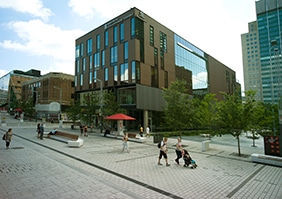Montreal’s LEED Platinum Centre for Sustainable Development
Montreal, Quebec
January 9, 2013
- Rating System/Standard
- LEED v1
- Certification Level
- Platinum
- Building Type
- Office
When the founding members of the Centre for Sustainable Development decided to create a unique, state-of-the-art space that exemplified sustainability and environmental education, they were hoping to create a new space that would inspire the community. Read about the amazing result of this collaborative project.
When the founding members of the Centre for Sustainable Development (Maison du Développement Durable) decided to create a unique, state-of-the-art space that exemplified sustainability and environmental education, they were hoping to create a new space that would inspire the community. After a great deal of carefully planned development and collaboration with community members, organizations, governments and industry experts from every discipline – the result has been truly astounding.
We spoke to Amélie Ferland Dufresne, Director of Communications and Programming for the Centre, about how the project came together, about how its many unique features that contributed to LEED Platinum certification, and about how the Centre’s example will educate others to build green.
Tell us a little about the building and its special features, especially those that led to the LEED Platinum certification.

The Centre for Sustainable Development is one of the first commercial buildings to certify LEED® Platinum for New Construction in the downtown core of a Canadian city. It is also one of the most efficient buildings in terms of energy amongst offices in Quebec, with a green roof, incredibly efficient lighting, an outer envelope that includes windows with triple glass and films of low emissivity, and heating and cooling that comes from 28 geothermal wells.
The Centre was designed to optimize the relationship between the well-being of users and the environmental impacts, with particular attention to air quality, choice of materials, and the environmental management of energy, water and waste.
The Centre obtained four LEED credits by setting emission maximums for all of the following products: carpet, wood and laminates, adhesives and sealants, and paints and varnishes. For example, paint with a matte finish in the Centre does not contain more than 50g per litre of volatile organic compounds (VOCs).
The building is equipped with a basin for collecting rainwater for use in toilets. It also has infrared detectors and automatic low-flow faucets in order to prevent leakage and generally limit the amount of water being used when washing hands. The dual-flush toilets switch between 3.4 litres or 4.8 litres depending on how much is needed, and waterless urinals save significant amounts of water.
All general purpose concrete that was used includes fly ash waste from coal-fired power plants; fly ash, the solid residue derived from incineration processes, is used to offset Portland cement in concrete. A plate of experimental concrete, including a significant amount of recycled glass, is also being tested.
In addition to all of this, at least 50 per cent of all new wood used in the building comes from FSC certified forests; and 15 per cent of all materials are recycled products. For example, the gypsum board that was used is made of 99% recycled materials and the material used for the insulation is 70 per cent recycled content. There are five counters in the building’s kitchenettes and each is made up of 93 per cent recycled glass.
Lastly, the Centre for Sustainable Development set up a waste management plan that allowed the building to divert at least 90 per cent of the construction waste from landfill.
Why did you choose the LEED certification? What value does it bring to you as a building owner/property manager?
For several years, employees and volunteers who were working for Équiterre were in an unsuitable environment. In 2002, the management of Équiterre had the choice to move its location to new space for its occupants; one that was both accessible and inspiring. Équiterre then decided to make the entire project into an educational opportunity, one that constructed an exemplary building that would inspire local citizens, experts and elected officials, as well as encourage others to do the same in Quebec. The team chose to aim for LEED Platinum from the beginning because LEED’s rigour and high environmental standard matched the Centre’s high environmental record.
The objectives pursued by the Centre for Sustainable Development were that it aims to build the future through:
- Maximizing the potential for the Centre and outside organizations to share social and environmental resources.
- Act as a centre for reflection, education, innovation and as a meeting place for thought leaders where they can discuss sustainable development.
- Provide citizens, businesses and governments with new educational tools on sustainable development.
- Provide Canadian researchers a great tool for researching green building.
What value does LEED certification bring to your building, both as an owner and/or property manager and for those the tenants who occupy it?

LEED as an environmental certification standard was developed specifically according climates, construction practices and Canadian regulations, and it has provided a design guideline to improve the well-being for the building’s occupants, as well as to maximize environmental performance and the economic performance of the building.
For example, in the office space, a plenum of 305mm in height was put between the concrete slab and floor area which is used to supply ventilated air for those who occupy the space. This system requires less energy than conventional ventilation because it brings air into the office at a low speed down at ground level, and pushes it directly into the space occupied by the employee, which improves comfort.
In addition, LEED helped us decide to optimize the positioning and size of the windows to maximize the entry of natural light and views within the building. The use of automated management tools (with sensors and brightness) and the implementation of efficient appliances that had bulbs with low mercury levels (T5 and LED) helped significantly reduce the electricity consumption of the building.
The building is covered with an extensive green roof with an area of over 800m2. The vegetation is composed of at least 10 varieties of plants (pre-cultivated Instagreen sedum). This reduces heat island effect, aids energy consumption and contributes to the building’s sewage and wastewater.
Obviously, the certification also has value in terms of reputation. It ensures that the work was done professionally and in accordance with very high standards. Thus, the Centre is able to benefit from visibility amongst the universities and in the media, as well as with elected officials and other experts.The credibility provided by LEED certification generates a value that is priceless!
What is the biggest lesson you learned in achieving a LEED project that would be useful for other LEED projects?

From the point of view of building science, the greatest thing we learned working on this project was not so much with the final product but the importance of cooperation and sharing during the process. During all stages of the design and construction of the Centre, Équiterre and all the parties involved (architects, consulting engineers, general contractors, researchers, suppliers , etc.) worked in multidisciplinary teams to reach innovative solutions, putting into practice integrated design which was essential to the success of this project.
When Équiterre started the project, we had no money, no land and no real expertise in real estate development but we were lucky enough to be surrounded by amazing partners that stayed with us throughout the project. Real estate developers, lawyers and property managers have given their time; governments, corporations and foundations have donated money, and citizen groups gave a soul to the project, helping it overcome many challenges.
In total, more than 53 partners and private donors contributed to the implementation and financing of the Centre, including the Ministry of Sustainable Development, Environment and Parks (MDDEP ), the City of Montreal, Ville- Marie, the Business Development Corporation of Old Montreal, the Ministry of Municipal Affairs, Regions and Land Occupancy, and the Federation of Canadian Municipalities with Alcoa as the lead partner.
Would you like to add something else on your building or LEED in general?
To fulfill its mission of being a meeting point for discussion, trade and innovation toward sustainable development, the Centre for Sustainable Development now offers a free and varied program including guided tours, exhibitions, lectures, debates and workshops on current issues related to sustainable development.
The Centre also offers a self-guided course, free and open to the public, that has kiosks and information panels on the principles of green building and the techniques and materials used in the construction of the house.